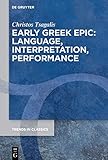Early Greek Epic: Language, Interpretation, Performance / Christos Tsagalis.
Material type: TextSeries: Trends in Classics - Supplementary Volumes ; 138Publisher: Berlin ; Boston : De Gruyter, [2022]Copyright date: ©2023Description: 1 online resource (XXIX, 637 p.)Content type:
TextSeries: Trends in Classics - Supplementary Volumes ; 138Publisher: Berlin ; Boston : De Gruyter, [2022]Copyright date: ©2023Description: 1 online resource (XXIX, 637 p.)Content type: - 9783110993721
- 9783110981407
- 9783110981384
- online - DeGruyter
- Issued also in print.
| Item type | Current library | Call number | URL | Status | Notes | Barcode | |
|---|---|---|---|---|---|---|---|
 eBook
eBook
|
Biblioteca "Angelicum" Pont. Univ. S.Tommaso d'Aquino Nuvola online | online - DeGruyter (Browse shelf(Opens below)) | Online access | Not for loan (Accesso limitato) | Accesso per gli utenti autorizzati / Access for authorized users | (dgr)9783110981384 |
Browsing Biblioteca "Angelicum" Pont. Univ. S.Tommaso d'Aquino shelves, Shelving location: Nuvola online Close shelf browser (Hides shelf browser)

|

|

|

|

|

|

|
||
| online - DeGruyter What It Is to Exist : The Contribution of Thomas Aquinas’s View to the Contemporary Debate / | online - DeGruyter Theatre and Autocracy in the Ancient World / | online - DeGruyter Der Tierstil II im Merowingerreich / | online - DeGruyter Early Greek Epic: Language, Interpretation, Performance / | online - DeGruyter Testi trevigiani della prima metà del Trecento : Edizione, commento linguistico e glossario / | online - DeGruyter The Road to Ukraine : How the West Lost its Way / | online - DeGruyter Übungen im Kapitalgesellschaftsrecht : Mit Bezügen zum Venture Capital / |
Frontmatter -- Preface -- Contents -- List of Abbreviations -- List of the Original Publication Venues -- List of Tables -- Introduction -- Part I: Homer -- 1 Towards an Oral, Intertextual Neoanalysis -- 2 Detextualizing Homer: Intonation Units, Background Knowledge, and the Proems of the Iliad and the Odyssey -- 3 The Dynamic Hypertext: Lists and Catalogues in the Homeric Epics -- 4 Naming Helen: Localization, Meter, and Semantics of a Homeric Character -- 5 Epic Space Revisited: Narrative and Intertext in the Episode between Diomedes and Glaucus (Il. 6.119–236) -- 6 Ἀπ᾽/κατ᾽ αἰγίλιπος πέτρης: Homeric Iconyms and Hittite Answers -- 7 Revisiting an Old Crux: Iliad 11.609–610 -- 8 Iliad 11.662: A Note -- 9 Deauthorizing the Epic Cycle: Odysseus’ False Tale to Eumaeus (Od. 14.199–359) -- Part II: Hesiod -- 10 Poetry and Poetics in the Hesiodic Corpus -- 11 Soundplay in the Hesiodic Catalogue of Women -- Part III: The Epic Cycle -- 12 The Gods in Cyclic Epic -- 13 γυναίων εἵνεκα δώρων: Interformularity and Intertraditionality in Theban and Homeric Epic -- 14 Cypria fr. 19 (PEG, GEF): A Reconsideration -- 15 Telegony -- 16 Verses Attributed to the Telegony -- Part IV: The Performance of Epic -- 17 Ἀοιδός and ῥαψῳδός: Methodological Problems and Assumptions -- 18 Performance Contexts for Rhapsodic Recitals in the Archaic and Classical Periods -- 19 Performance Contexts for Rhapsodic Recitals in the Hellenistic Period -- 20 Rhapsodes and Rhapsodic Recitals in the Imperial Period -- Bibliography -- General Index -- Index of Hesiodic and Homeric Passages
restricted access online access with authorization star
http://purl.org/coar/access_right/c_16ec
In the last fifty years major developments have taken place, both in the field of Homeric studies and in the rest of early Greek epic. These developments have not only created a more solid basis for studying the Homeric epics, but they have also broadened our horizons with respect to the place of Homeric poetry within a larger cultural milieu. The impressive advances in Hesiodic studies, the more systematic approach to the Epic Cycle, the more nuanced use and re-evaluation of dominant twentieth-century theories like Neoanalysis and Oral Theory, the study of other fragmentary Greek epic, the cognitive turn, narratology, the performance of epic poetry in the ancient and modern world, the fruitful utilization of Indo-European material, and the widely accepted recognition of the close relation between Homer and the mythology and literature of the ancient Near East have virtually shaped anew the way we read and understand Homer, Hesiod, and early Greek epic. The studies collected in this volume are informed by most of the aforementioned sub-fields and span four research areas: (i) Homer; (ii) Hesiod; (iii) the Epic Cycle; (d) the performance of epic.
Issued also in print.
Mode of access: Internet via World Wide Web.
In English.
Description based on online resource; title from PDF title page (publisher's Web site, viewed 29. Mai 2023)


